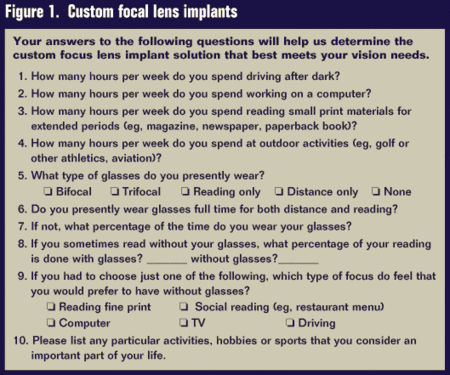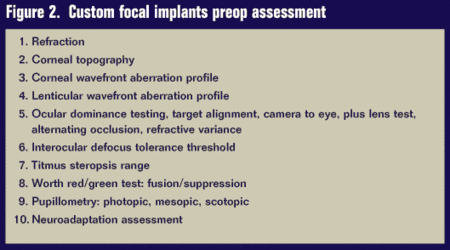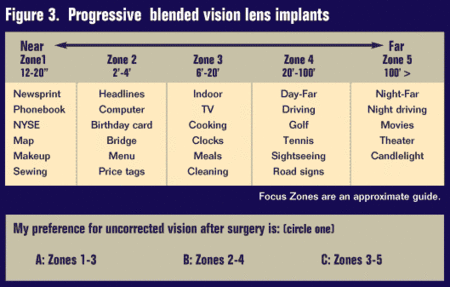Let the patient, not the technology, guide approach in presbyopia correction
A patient questionnaire, preop tests and a focus zone chart can help determine a patient’s “presbyopia profile.”
A generation ago, David V. Leaming, MD, tracked the revolutionary transition from extracapsular cataract extraction to phacoemulsification in his annual American Society of Cataract and Refractive Surgery membership survey. Between 1985 and 1995, Dave published the phaco data annually in our Ocular Surgery News column Focus on Phaco. During that dramatic decade, use of phaco increased from 10% to 90%, replacing a very good ECCE technique in the process.
According to the 2004 survey, it is likely that we are at a similar juncture in the transition to refractive lens exchange (RLE). Even as wavefront custom ablation has become increasingly available, photorefractive procedures are waning (down 3%) as the percentage of surgeons who regularly perform RLE increased by 6% to 31%.
As I have said before, RLE is part of the second phase of Ridley’s IOL revolution, and this survey is telling us that phase 2 is now well under way. As the IOL is utilized in earnest on the refractive side of the 20/20 threshold, it assumes its rightful place as a mainstay in vision correction. The considerable corrective capability of the IOL — no longer for cataract patients only — will benefit a wide range of refractive candidates. No group is likely to benefit more than the largest demographic segment, the presbyopes.
More than one technique
Despite having several alternatives, surgeons have thus far tended to rely on one or another approach for the treatment of presbyopia. As we are still early in using the lens-based approach, it is understandable that we tend to stay with what we know best. This tendency also reflects an over-reliance on one or another specific IOL technology, which is fairly typical at this stage.
In time, an understanding of the art involved in a new surgical approach begins to take hold. Typically, as we develop our own instinctual feel, we realize that any given IOL technology is but a small part of consistently successful results. This has certainly been my experience, as I have come to see the surgical correction of presbyopia as a broad-ranging approach, rich with nuance and utilizing several techniques. In my view, presbyopia surgery necessarily involves more than the latest lens implant technology.
Customized treatment
Many of my early assumptions about correcting presbyopia were off the mark. Gradually I have come to understand that our task is not to eliminate a fixed amount of presbyopia but to restore a certain range of close focus. In providing an intraocular optical compensation for presbyopia’s most unwanted effects, we attempt to restore the particular segment of near focus that is of most concern to each candidate. When I realized how widely individual near vision needs vary, I came to understand that for an approach to be effective, it must be tailored to differing specific needs.
Factors including ametropia, personal and professional near and distance vision requirements, and the level of expectation all determine the specific result that will satisfy each candidate. The targeted result must be in accordance with this set of individual factors — the patient’s “presbyopia profile.” Presently, there is no one-size-fits-all technology.
Treatment, not a cure
Short of a cure, there can be no universally suitable result because of widely varying needs. Therein lies the challenge and the highly satisfying art of surgical presbyopia treatment using today’s IOLs — the art of the compromise. There is no happier patient than a presbyope whose reading has been restored. Unlike a myope after LASIK, a presbyope suddenly regains something he thought was gone forever. Remembering the way it was, he tends to feel free and whole again.
There is every indication that we are still far from a procedure that restores the dynamic, seamless, infinite range of auto-focus capability once experienced with natural accommodation. In fact, it is increasingly clear that we are only now beginning to fully understand the intricacies of the accommodative mechanisms we seek to replicate.
The reports of Adrian Glasser, PhD, and others who study presbyopia have convinced me that true accommodation will not be surgically restored within the next decade, if ever.
Natural accommodation
Defocus, the specific aberration utilized by the focus-shift principle guiding today’s accommodative implants, is a start, and these implants are yet another tool for us to consider. But the defocus that results from a shift in lens position will not restore the natural accommodation that derives from lens deformation. Helmholtz’s theory, which was recently corroborated in several studies, holds not that the lens moves, but that it undergoes changes in curvature. Focus shift alone, should it ever prove capable of delivering 3 D of defocus, may lead us to a terrific treatment, but it can never be the cure.
This increasingly apparent limitation of focus-shift is behind the search for the next generation of IOLs for presbyopia — a deformable lens implant. But here again, nature’s crystalline lens is proving very difficult to re-create. Contrary to the widely accepted notion, it now appears that accommodation does not change lens curvature by simply adding thickness throughout, thereby increasing positive spherical aberration.
It seems that the crystalline lens deforms asymmetrically, thickening at the center as the periphery gets thinner, thus placing the more pronounced increase in optical power centrally. This asymmetrical deformation demonstrates greater negative spherical aberration, not the increased positive spherical aberration that we had thought occurred. Re-creating this intricate pattern of deformation in a prosthesis will prove much more challenging. The bar has just been raised in our search for the cure for presbyopia.
Compromises
If you read these reports, I think that you will agree that we are far from fully restoring natural accommodation. Until then, we are dealing with various treatments and must measure success much as we do with cancer or arthritis. Our treatments of presbyopia will be successful to the degree that they allow the patient to live more freely with this malady by circumventing its most troublesome symptoms.
All presbyopia treatments involve a visual compromise of one sort or another. This has been true since the monocle or bifocal and will remain true of present and future surgical treatments as well. New techniques will be considered an improvement to the extent that the compromise is lessened. But until we have a cure, managing this compromise will remain a critical prerequisite to success. My experience thus far has taught me that this compromise is managed best when the patient is an integral part of the process.
Target reading goals
Today’s surgical solutions can readily restore excellent acuity to a significant segment of the near vision range. For most patients, this is more than enough so long as they are able to choose the specific segment of reading focus that meets their greatest needs. Some presbyopes want a result that restores reading of stock listings in the business pages, while others seek only social reading such as a restaurant menu.
These are just two of a wide range of different reading vision results these patients are looking for. Each carries its own compromise. The patient’s presbyopia profile, not the technology, ought to determine the visual compromise involved. But this is clearly not possible using only one approach in which both the result and the compromise are predetermined by the IOL technology.
Assessing the presbyopia profile
Sorting through all of the variables involved in the presbyopia profile can consume a considerable amount of chair time. While I firmly believe that this process should not be delegated, it can be streamlined considerably using a patient questionnaire (Figure 1), a specific battery of tests (Figure 2) and a focus zone chart (Figure 3).
We developed these tools as a means of accurately and efficiently determining the presbyopia profile, while also actively involving the patient in selecting the compromise inherent in his targeted reading range. Our goal is to assure that the patient clearly understands what activities do and do not fall within that particular focus range and then select the procedure accordingly. This is how we currently use each of these tools in a comprehensive presurgical presbyopia evaluation.
- Patient questionnaire
Before a 30-minute preoperative appointment, the patient completes the questionnaire (Figure 1). Together with a complete ophthalmic history and exam, this provides essential information about the candidate’s lifestyle, personal and professional vision needs, and past and present refractive status. I review the responses before meeting with the patient and begin to formulate an initial broad impression of his presbyopia profile, the range of possible results that are compatible and the procedures capable of delivering them. The questionnaire serves as an agenda for further discussion until I am sure I understand the patient’s specific reading priorities.

(Source: Maloney WF.) - Preop testing
This series of tests (Figure 2) is an important part of refining the presbyopia profile and identifying the procedures that are likely precluded by one or another of the findings.

(Source: Maloney WF.) - Focus zone chart
After reviewing the questionnaire and test results, I give an explanation of accommodation and its gradual loss through presbyopia. The description of an auto-focus camera that gradually loses its close auto-focus capabilities is a useful analogy.

Focus Zones are an approximate guide.I explain each of the five focus zones (Figure 3) using a book of props, including sample stock pages, medicine labels, cell phone keypad, restaurant menus, books, various newsprint and magazines, TV listings, computer screen, food labels, recipes and a golf score card. The use of props, together with trial frame or loose lenses, is important to demonstrate the functional differences between “auto-focus” in zone 1 compared to zone 2.

(Source: Maloney WF.)When the patient demonstrates a solid understanding of the activities and range of focus that fall within each zone, I ask him to select the three contiguous zones for the uncorrected auto-focus segment of his vision. The patient then circles his selection and signs the form, which then becomes part of the medical record. This is the targeted reading result. With the presbyopia profile complete, the procedure is selected accordingly.
Treat the patient
As I see it, we are about to begin a very active period of lens-based treatments for presbyopia. A dizzying array of lens implants will likely come and go, each claiming to be the answer for presbyopia. Through it all, an irrefutable principle will remain at work. It will help us to separate the science from the salesmanship, a task that lately has become inordinately difficult, in my view.
The underlying governing reality is this: As long as the entire range of optical properties responsible for natural accommodation is not fully at work in the lens implant we use, we are not restoring accommodation, but rather providing another form of optical compensation for presbyopia that requires visual compromise. As surgeons, we will continue to be required to understand and properly manage that compromise as an integral part of our treatment. Our surgical goal is a fully satisfied patient, not a fixed amount of presbyopic reduction. Such a moving target requires that we carefully assess each patient and then select the treatment accordingly.
Next month
Our next column will describe the process of selecting one of the following approaches according to the individual presbyopia profile: contact lens monovision, conductive keratoplasty, multifocal IOL, diffractive-multifocal IOL, accommodative IOL or pseudophakic monovison (also called blended vision implants). Except for contact lens monovision and CK, which are reserved for partial presbyopes, these procedures are the same whether we are treating presbyopia in a cataract patient or RLE candidate.
References:
- Glasser A, Campbell MC. Biometric, optical and physical changes in the isolated human crystalline lens with age in relation to presbyopia. Vision Res. 1999;39(11):1991-2015.
- Glasser A, Kaufman PL. The mechanism of accommodation in primates. Ophthalmology. 1999;106(5):
863-872.- Roorda A, Glasser A. Wave aberrations of the isolated crystalline lens. J Vis. 2004;4(4):250-261.
- Vilupuru AS, Roorda A, Glasser A. Spatially variant changes in lens power during ocular accommodation in a rhesus monkey eye. J Vis. 2004;4(4):299-309.
